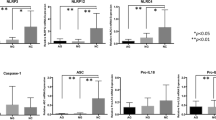Abstract
Purpose
Hirschsprung’s disease -associated enterocolitis (HAEC) is the most common cause of morbidity and mortality in Hirschsprung’s disease (HSCR). Altered intestinal epithelial barrier function is implicated in the pathogenesis of HAEC. IL-17 is a proinflammatory cytokine that plays a crucial role in host defense against microbial organisms in the development of inflammatory diseases. Act1 is an essential adaptor molecule required for the IL-17-mediated inflammatory responses via interaction with IL-17 receptor (IL-17R). We designed this study to investigate the hypothesis that Act1/Il-17R expression is upregulated in HSCR.
Methods
We investigated Act1 and IL17R expression in ganglionic andaganglionic bowel of HD patients (n = 10) and controls (n = 10). qPCR, Western blotting and confocal immunofluorescence were performed.
Main results
qPCR and Western blot analysis revealed that Act1 and IL17R are strongly expressed in the aganglionic and ganglionic colon of patients with HSCR. Act1 and IL17R expression was significantly increased in HSCR specimens compared to controls (p < 0.05). Confocal microscopy revealed a markedly increased expression of Act1 and IL17R in the colonic epithelium of patients with HSCR compared to controls.
Conclusion
To our knowledge, we report, for the first time, the expression of Act1 in the human colon. The increased expression of Act1 and Il-17 in the aganglionic and ganglionic bowel in HSCR may result in IL-17-mediated increased inflammatory response leading to the development of HAEC




Similar content being viewed by others
References
Holschneider AM, Puri P (2008) Hirschsprung’s disease and allied disorders. Springer, Berlin
Peña A, Bischoff A (2015) Surgical treatment of colorectal problems in children. Springer, Cham
Puri P, Ohshiro K, Wester T (1998) Hirschsprung’s disease: a search for etiology. Semin Pediatr Surg 7(3)
Puri P, Shinkai T (2004) Pathogenesis of Hirschsprung’s disease and its variants: recent progress. Semin Pediatr Surg
Demehri FR, Halaweish IF, Coran AG, Teitelbaum DH (2013) Hirschsprung-associated enterocolitis: pathogenesis, treatment and prevention. Pediatr Surg Int 29(9):873–881
Murphy F, Menezes M, Puri P (2008) Enterocolitis complicating Hirschsprung’s disease. Hirschsprung’s Dis Allied Disord, Berlin-Heidelberg
Neuvonen MI, Kyrklund K, Lindahl HG, Koivusalo AI, Rintala RJ, Pakarinen MP (2015) A population-based, complete follow-up of 146 consecutive patients after transanal mucosectomy for Hirschsprung disease. J Pediatr Surg 50:1653–1658
Austin KM (2012) The pathogenesis of Hirschsprung’s disease-associated enterocolitis. Semin Pediatr Surg 21:319–327
Yan Z, Poroyko V, Gu S et al (2014) Characterization of the intestinal microbiome of Hirschsprung’s disease with and without enterocolitis. Biochem Biophys Res Commun 445:269–274
Snoek SA, Verstege MI, Boeckxstaens GE, van den Wijngaard RM, de Jonge WJ (2010) The enteric nervous system as a regulator of intestinal epithelial barrier function in health and disease. Expert Rev Gastroenterol Hepatol 4:637–651
Onishi RM, Gaffen SL (2010) Interleukin-17 and its target genes: mechanisms of interleukin-17 function in disease. Immunology 129:311–321
Friedrich M, Diegelmann J, Schauber J, Auernhammer CJ, Brand S (2015) Intestinal neuroendocrine cells and goblet cells are mediators of IL-17A-amplified epithelial IL-17C production in human inflammatory bowel disease. Mucosal Immunol 8:943–958
Song X, Dai D, He X et al (2015) Growth factor FGF2 cooperates with interleukin-17 to repair intestinal epithelial damage. Immunity 43:488–501
Park H, Li Z, Yang XO et al (2005) A distinct lineage of CD4 T cells regulates tissue inflammation by producing interleukin 17. Nat Immunol 6:1133–1141
Chang SH, Park H, Dong C (2006) Act1 adaptor protein is an immediate and essential signaling component of interleukin-17 receptor. J Biol Chem 281:35603–35607
Dong C (2006) Diversification of T-helper-cell lineages: finding the family root of IL-17-producing cells. Nat Rev Immunol 6:329–333
Ruddy MJ, Wong GC, Liu XK et al (2004) Functional cooperation between interleukin-17 and tumor necrosis factor-alpha is mediated by CCAAT/enhancer-binding protein family members. J Biol Chem 279:2559–2567
Gu C, Wu L, Li X (2013) IL-17 family: cytokines, receptors and signaling. Cytokine 64:477–485
Qian Y, Qin J, Cui G et al (2004) Act1, a negative regulator in CD40- and BAFF-mediated B cell survival. Immunity 21:575–587
Gosain A, Barlow-Anacker AJ, Erickson CS et al (2015) Impaired cellular immunity in the murine neural crest conditional deletion of endothelin receptor-B model of Hirschsprung’s disease. PLoS One 10:e0128822
Moore SW, Johnson G, Schneider JW (2000) Elevated tissue immunoglobulins in Hirschsprung’s disease—indication of early immunologic response. Eur J Pediatr Surg 10:106–110
Iwakura Y, Ishigame H (2006) The IL-23/IL-17 axis in inflammation. J Clin Invest 116:1218–1222
Qian Y, Liu C, Hartupee J et al (2007) The adaptor Act1 is required for interleukin 17-dependent signaling associated with autoimmune and inflammatory disease. Nat Immunol 8:247–256
Ward NL, Pieretti A, Dowd SE, Cox SB, Goldstein AM (2012) Intestinal aganglionosis is associated with early and sustained disruption of the colonic microbiome. Neurogastroenterol Motil 24:874-e400
Cani PD, Possemiers S, Van de Wiele T et al (2009) Changes in gut microbiota control inflammation in obese mice through a mechanism involving GLP-2-driven improvement of gut permeability. Gut 58:1091–1103
Zhao Z, Qian Y, Wald D, Xia YF, Geng JG, Li X (2003) IFN regulatory factor-1 is required for the up-regulation of the CD40-NF-kappa B activator 1 axis during airway inflammation. J Immunol 170:5674–5680
Author information
Authors and Affiliations
Corresponding author
Rights and permissions
About this article
Cite this article
Tomuschat, C., O’Donnell, A.M., Coyle, D. et al. Increased Act1/IL-17R expression in Hirschsprung’s disease. Pediatr Surg Int 32, 1201–1207 (2016). https://doi.org/10.1007/s00383-016-3980-4
Accepted:
Published:
Issue Date:
DOI: https://doi.org/10.1007/s00383-016-3980-4




